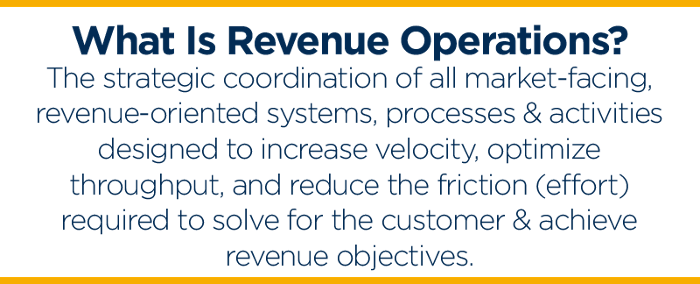 Revenue operations (RevOps) is a hot topic these days, and there are very compelling reasons. Companies that excel in key areas of RevOps enjoy 19% higher growth rates and 15% greater profitability. With customer acquisition costs are rising at increasing rates and record investments in technology not translating into greater productivity or outcomes, this type of performance deserves the attention that it’s getting.
Revenue operations (RevOps) is a hot topic these days, and there are very compelling reasons. Companies that excel in key areas of RevOps enjoy 19% higher growth rates and 15% greater profitability. With customer acquisition costs are rising at increasing rates and record investments in technology not translating into greater productivity or outcomes, this type of performance deserves the attention that it’s getting.
We’ve long evangelized the belief that long-term success is more about the plumbing and structure that enables execution than it is about the great strategies that tend to get the credit. For this reason, we’re all in on the trend towards revenue operations and have been since before people were calling it RevOps.
However, there’s a common problem we’ve seen with trends that get this hot. They quickly devolve into buzzwords and empty gestures, promising quick fixes and magic elixirs. They quickly move up the hype cycle. Far too often, they end up merely contributing to the noise, confusion, and chaos increasingly dominating the operational environment for executives.
Readers of this blog know that while the team at Lift prides itself on being at the leading edge, we also take a skeptical view of those trends that suddenly emerge with intense popularity. When sales enablement achieved buzzword status, we sought to clearly answer two important questions before anointing a new function/tactic as worthy of the attention of serious players -- and we’re doing the same thing with RevOps.
- Is this accretive? Does it increase velocity? (Is the juice worth the squeeze)?
- Is there an operative definition that provides a strategic direction/guiding philosophy for successful execution? If the answer isn’t “yes,” then that the function/tactic is not distinct from those that already exist. That means we’ll then either ignore it or view it through the lens of a deepening or specialization of the appropriate discipline. “Conversational marketing” is a perfect example of a tactic that got (and still gets) a lot of attention, but doesn’t stand out on its own.
With RevOps, we were pretty quick to determine that it’s accretive, but it took us a while (and a lot of research and debate) to answer “yes” to the second question. We saw lots of definitions provided by a broad range of organizations. Unfortunately, most of them were from martech providers who were selling apps.
We initially viewed RevOps as simply a new term for Sales Operations. But, we kept coming back to the research we reviewed and our own firsthand experiences that showed meaningful differences in the outcomes presented when friction is materially reduced. We couldn’t simply attribute the differences to some organizations doing sales operations well, and some not. The results are driven by something different in kind, not just degree.
So we dug into the actionable differences, or what we call the “double delta,” to find what the top performers are doing that the others aren’t doing and what they are not doing that the others are doing.
We were very excited by our findings, and it enabled us to create the operational definition needed to meet our second criterion. Revenue Operations (RevOps) is:
The strategic coordination of all market-facing, revenue-oriented systems, processes & activities designed to increase velocity, optimize throughput, and reduce the friction (effort) required to solve for the customer & achieve revenue objectives.

The job of revenue operations is to solve as much of the problem and to eliminate as much of the negative friction as possible before it gets to execution so that we can execute in low-friction environments. That's what enables growth revenue. It does this by focusing on seven areas. If you look closely at these areas, you’ll see that they break down into two groups. The first four are the day-to-day, week-to-week focus of revenue operations, and the last three are the structural and strategic components.
1. Database Management
Data is crucial. Today the database is far more than a storage receptacle of contact information and a history of activities. In an aligned organization, the database is the core, fueling everything. If you don’t have a robust database, you’ll be paying a significant friction tax.
This complexity is a primary reason that there is a need for the type of strategic revenue operations described in this post. Some of the critical areas of responsibility in this area are:
- Managing & maintaining the database
- Ensuring data integrity
- Segmentation
- Unifying data across functions and departments
- Establishing and monitoring a data management SLA (service level agreement)
2. Process Compliance & Optimization
What are the processes used to manage overall performance, customer/user experience, and how are you ensuring the utilization of those systems? These are the systems our teams are working in on a day-to-day, minute-to-minute basis. They're fraught with friction and small conflicts.
Revenue operations ensure that these conflicts are managed, and the systems, tools, and processes are being used as intended while managing the adjustments necessary to maximize velocity.
3. Design, Align & Optimize The Tech Stack
More money than ever is being spent on technology, yet technology rarely delivers the outcomes that justified their purchase. Far more often, technology creates additional friction.
Revenue operations should:
- Define the core requirements for all revenue-focused applications
- Manage the backend and technical aspects of (at least) the core and primary segments of the tech stack
- Ensure applications solve for the whole
- Regularly prune and update
4. Data Science, Analytics & Metrics
My company (which is relatively small) creates more new data in a day than a human can meaningfully consume in a lifetime. I remember doing seminars in the early 1990s about the importance of data and metrics. My mom (it was a family-owned business) would share:
We’re drowning in data, yet starved for knowledge.
Mom (I know you’re reading this blog), how would you describe circumstances today?
Getting the right data, in the right way, at the right time, and ensuring that the right people receive it in the best manner to utilize: this is increasingly a competitive advantage. Within the next 24 months, it likely won’t be an advantage; it will be a requirement.
We’re currently creating a guide to data science for sales, marketing, and customer success teams (so I’ll save the details of this area for the guide). Here are the key areas of focus:
- Set up the data-gathering process
- Build out and manage appropriate dashboards
- Curate and drive insights to the relevant teams that stimulate new tests or inform existing ones
- Forecasting
- Ongoing assessments and adjustments to increase the predictability of the organization
5. Territory & Compensation Management
The overall structure and approach for the organization should be determined by the company’s senior team responsible for setting the strategy. (The RevOps leader should have a seat at the table.) Within those contracts, RevOps becomes responsible for managing, monitoring, and optimizing its implementation.
6. Structure & System Design
At 2019’s Inbound conference, I presented The Ultimate Sales Manager: Coaching Reps to Coach Themselves. In that presentation, I shared one of the most important lessons of my business career. Structure dictates everything. Realize that your current system (in the broad sense of the term) is perfectly designed to produce the precise results that you are getting. If you want to change your outcomes (in anything more than a short-term burst), you must change the design of your system.
The Second Law of Thermodynamics is that entropy is always increasing. Entropy represents disorder and randomness. In your business, this disorder means more friction. As a business grows (or simply survives), it becomes more complex, and that complexity creates conflict. Friction slows you down.
Revenue Operations is responsible for designing, managing, and optimizing the design of the processes, tools, and scoreboards to enable frictionless execution and to maximize its outcomes.
7. Behavioral Science & User Experience
One of my favorite memes highlights the difference between what “makes sense” and what actually works.
I’ve reviewed hundreds of growth initiatives and the strategy, structure, and processes used to enable them. Time and time again, my main observation is how well-thought-out these efforts are if only people weren’t involved.
The primary reason that initiatives like RevOps fail is that those involved in creating them view the human element as a bug rather than a feature, which leads to one of two places (neither of which are good):
- They autotune their sales, marketing, and success teams, which leads to even more aggressive commoditization.
- The effort and investments made to reduce/eliminate friction end up creating more friction and chaos, which is why far too many salespeople refer to their operations teams as the sales prevention department.
Remember, all of the investments you’re making in technology, enablement, content, and more are designed to influence behavior. If you want to influence it positively, you need to be paying attention to and accounting for how humans actually behave. It’s the difference between theory and reality.
Some Resources to Optimize RevOps
If you’d like to see how to ramp up and integrate revenue operations, you’ll enjoy this webinar.
Don’t miss Inbound 2020 when I am presenting Eliminating Friction: How Revenue Operations Can Generate 30% More Revenue From Your Existing Efforts. With Inbound20 going virtual this year, the presentation will be broken into two parts. The first will be a presentation you’ll watch on demand. The second will be a live Q&A.

 Doug Davidoff
Doug Davidoff
